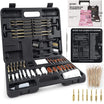As the days grow shorter and the air turns cooler, it's time to shift your focus to harvesting root vegetables before winter arrives. Root vegetables like carrots, beets, potatoes, and parsnips thrive during the cooler months, but knowing when and how to harvest them is key to preserving their quality and flavor. With proper harvesting and storage techniques, you can enjoy your garden’s bounty well into the colder months.
Why Harvest Root Vegetables in Late Fall?
Root vegetables are generally hardy crops, capable of growing in cooler temperatures. However, they are not immune to frost damage, especially when temperatures drop below freezing. Harvesting them in late fall ensures that they maintain their optimal taste and nutritional value. Root vegetables develop a natural sweetness in response to cooler soil temperatures, making late fall the ideal time to pick them.
When to Harvest Root Vegetables
The timing of your harvest depends on the type of root vegetable and the local climate. Here are some general guidelines:
- Carrots: These can be harvested once they reach a desirable size, usually 1-2 inches in diameter. In cooler climates, they should be harvested before the ground freezes solid.
- Beets: Harvest when they are about 2-3 inches in diameter, as larger beets can become woody. Beets are more cold-hardy than other roots, but they should still be picked before the soil freezes.
- Potatoes: Dig up potatoes when the foliage starts to die back, usually 2-3 weeks after the plant flowers. Make sure to harvest before a hard freeze.
- Parsnips: These can remain in the ground longer, as they actually taste better after a light frost. However, they should be harvested before the ground freezes to prevent them from becoming inedible.
How to Harvest Root Vegetables Safely
Proper harvesting techniques not only help prevent damage but also ensure the longevity of your vegetables in storage. Here’s how to do it effectively:
- Loosen the Soil: Use a garden fork or shovel to gently loosen the soil around the plant, taking care not to pierce or cut the roots.
- Pull Gently: Grasp the tops of the vegetables firmly but gently, and pull them from the soil. For stubborn roots like carrots or parsnips, use a trowel to help lift them from the ground.
- Shake Off Excess Dirt: Remove excess dirt from the roots but avoid washing them, as moisture can encourage rot during storage.
- Trim the Tops: Trim the leafy tops to about 1 inch above the root, as leaving longer tops can draw moisture away from the vegetables.
Storing Root Vegetables for Maximum Freshness
Proper storage is crucial for keeping root vegetables fresh over the winter months. Here are some of the best methods for storing different types of root vegetables:
-
Root Cellar: If you have a root cellar or a cool, dark basement, it’s the ideal place to store root vegetables. Ensure temperatures stay between 32-40°F with high humidity (85-95%).
- Carrots and Parsnips: Store in sand or sawdust, keeping them moist but not wet. This prevents the roots from shriveling.
- Beets and Potatoes: Store them in ventilated crates or bins, but keep them away from direct light to prevent sprouting or greening.
-
Refrigeration: If you don’t have a root cellar, a refrigerator can work as a backup storage method.
- Carrots and Beets: Place them in plastic bags with a few holes for ventilation. They can last for several weeks to months when stored this way.
- Potatoes: Store potatoes in a paper bag or cardboard box in a dark, cool place like a garage or unheated basement, but avoid the fridge, as temperatures below 40°F can cause them to develop a sweet taste.
-
In-Garden Storage: For crops like parsnips and carrots, consider leaving them in the ground, covered with a thick layer of mulch. This will insulate them from hard freezes, allowing you to harvest as needed throughout early winter.
Troubleshooting Common Storage Issues
Even with proper storage, issues can arise. Here are some common problems and how to address them:
- Sprouting: If root vegetables, especially potatoes, start to sprout, it means they are exposed to too much warmth or light. Move them to a cooler, darker location.
- Rotting: Excess moisture can cause rot. Check the storage area for leaks or high humidity, and ensure proper ventilation.
- Shriveling: Shriveling indicates low humidity. To increase humidity, place a damp cloth near the storage area but avoid direct contact with the vegetables.
Enjoying Your Root Vegetables Throughout Winter
Properly stored root vegetables can last well into winter, providing a nutritious addition to your meals. Roasting, stewing, or adding them to soups and casseroles are just a few ways to enjoy them. The natural sweetness and earthy flavors of these vegetables make them a staple for hearty winter meals, keeping you nourished and warm throughout the cold months.
By following these harvesting and storage tips, you’ll not only maximize the lifespan of your root vegetables but also enhance your winter menu with fresh, homegrown ingredients.























Leave a comment
All comments are moderated before being published.
This site is protected by hCaptcha and the hCaptcha Privacy Policy and Terms of Service apply.